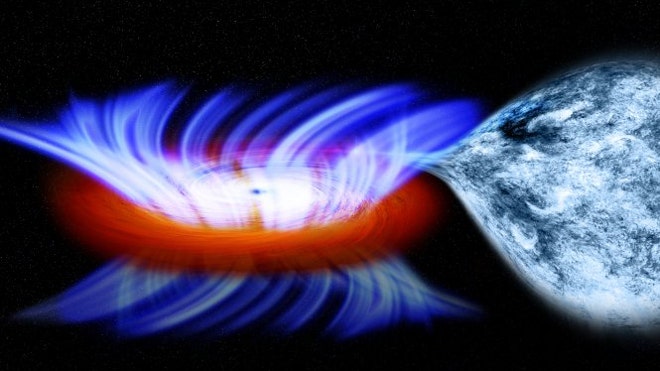|
|
| | 1 | 2 | 3 | 4 |
| 5 | 6 | 7 | 8 | 9 | 10 | 11 |
| 12 | 13 | 14 | 15 | 16 | 17 | 18 |
| 19 | 20 | 21 | 22 | 23 | 24 | 25 |
| 26 | 27 | 28 | 29 | |
|
| |
|
|
|
|
|
|
|
|
Cosmic hurricane: black hole has 20 million MPH winds นักวิทยาศาสตร์วัดค่าความเร็วลมพายุในแบล็คโฮลด์
 | |  | |

Scientists have measured the fastest winds yet observed from a stellar-mass black hole, shedding light on the behavior of these curious cosmic objects.
The winds, clocked by astronomers using NASA's Chandra X-ray Observatory, are racing through space at 20 million mph (32 million kph), or about 3 percent the speed of light. That's nearly 10 times faster than had ever been seen from a stellar-mass black hole, researchers said.
"This is like the cosmic equivalent of winds from a Category 5 hurricane," study lead author Ashley King, of the University of Michigan, said in a statement. "We weren't expecting to see such powerful winds from a black hole like this."
A stellar-mass black hole, which is born when an extremely massive star collapses, typically contains about five to 10 times the mass of our sun. The stellar-mass black hole powering this super wind is known as IGR J17091-3624, or IGR J17091 for short.
IGR J17091 is a binary system in which a sun-like star orbits a black hole. It's found in the central bulge of our Milky Way galaxy, about 28,000 light-years from Earth.
IGR J17091's wind matches some of the fastest generated by supermassive black holes, which are millions or billions of times more massive. Supermassive black holes are thought to reside at the heart of most if not all active galaxies, including our own Milky Way.
"It's a surprise this small black hole is able to muster the wind speeds we typically only see in the giant black holes," said co-author Jon Miller, also from the University of Michigan. "In other words, this black hole is performing well above its weight class."
Another surprising finding from the new study is that the wind, which comes from a disk of gas surrounding the black hole, may be blasting more material into space than the black hole is capturing.
"Contrary to the popular perception of black holes pulling in all of the material that gets close, we estimate up to 95 percent of the matter in the disk around IGR J17091 is expelled by the wind," King said.
Unlike hurricane winds on Earth, the wind from IGR J17091 is blowing in many different directions at once. This pattern distinguishes it from a jet, in which material flows in focused beams perpendicular to a black hole's disk, often at nearly the speed of light.
Jets have been seen coming from IGR J17091 before. But observations made with the National Radio Astronomy Observatory's Expanded Very Large Array in New Mexico showed that a radio jet from the system was not present when the super-fast wind was blowing.
This agrees with observations of other stellar-mass black holes, suggesting that ultra-speedy winds can quash jet production, researchers said.
Scientists estimated IGR J17091's wind speeds using a spectrum made by Chandra in 2011. Observations made by the space telescope two months earlier showed no such winds, meaning the black hole's gale likely switches on and off over time.
Astronomers think that magnetic fields in the accretion disks of black holes are responsible for producing both winds and jets. Characteristics of the magnetic fields and the rate at which material falls toward the black hole are thought to determine whether jets or winds are produced, researchers said.
แปลไทย
นักวิทยาศาสตร์ได้ค้นพบกระแสลมรุนแรงหลังจากที่ได้สังเกตุการณ์ แบล็คโฮลด์ stellar-mass รวมทั้งยังพบว่ามีแสงที่ส่องออกมาจากตัวมันด้วย
กระแสลม ถูกจับเวลาโดยนักดาราศาสตร์ จากหอดูดาว Chandra X-ray
พบว่ามีความเร็วสูงถึง 20 ล้านไมล์ต่อชั่วโมง (32 ล้าน กิโลเมตร ต่อชั่วโมง) หรือคิดเป็น 3% ของความเร็วแสง. นักดาราศาสตร์กล่าวว่า ความเร็วของมันเร็วกว่าเกือบ 10 เท่าของกระแสลมอื่นที่สังเกตุจาก แบล็คโฮลด์ stellar-mass
"นี้มันเปรียบได้กับ พายุระดับ 5 ในจักรวาล" จากการศึกษาครั้งนี้ ทำให้ Ashley King นักเขียนประจำมหาวิทยาลัยมิชิแกน กล่าวว่า "เราไม่เคยคิดว่าจะได้เห็นพายุที่มีกำลังมหาศาลขนาดนี้จากแบล็คโฮลด์นี้
Stellar-mass แบล็คโฮลด์เกิดขึ้นจากการดับสูญของดาวฤกษ์ขนาดใหญ่ที่ประมาณการว่ามีขนาดใหญ่กว่าพระอาทิตย์ของเราประมาณ 5-10 เท่าตัว Stellar-mass แบล็คโฮลด์ได้ทำให้เกิดมหาพายุที่เราเรียกกันว่า IGR J17091-3624 หรือเรียกสั้นๆว่า IGR J17091
IGR J17091 คือรหัสของดาวกึ่งดาวฤกษ์ที่โคจรในแบล็คโฮลด์ มันได้ถูกค้นพบอยู่ในใจกลางของทางช้างเผือกของเรา, อยู่ห่างไปจากโลกประมาณ 28,000 ปีแสง
กระแสลมที่เกิดจาก IGR J17091 สามารถเปรียบได้กับกระแสลมที่เร็วที่สุดที่เกิดจากSuper แบล็คโฮลด์ที่มีขนาดใหญ่กว่าล้านหรือพันล้านเท่า
Super แบล็คโฮลด์ซึ่งถูกประมาณไว้ว่าจะอาศัยอยู่ในใจกลางของกาแลคซี่ส่วนใหญ่ ถ้าไม่นับรวมกาแลคซี่ที่ยังตื่นอยู่รวมทั้งทางช้างเผือกของเรา
"มันน่าแปลกใจว่าแบล็คโฮลด์ขนาดเล็กนี้จะสามารถทำให้เกิดกำลังลมพายุซึ่งเรามักจะเห็นอยู่ในเฉพาะแบล็คโฮลด์ขนาดยักษ์" ผู้ช่วยนักเขียนประจำมหาวิทยาลัยมิชิแกน "จอน มิลเลอร์" ได้ให้ความเห็น "หรือเราจะพูดอีกอย่างก็ได้ว่า แบล็คโฮลด์นี้กำลังทำได้ดีเกินกว่าพิกัดน้ำหนักของมัน
สิ่งที่หน้าแปลกยิ่งกว่าก็คือจากการศึกษาพบว่ากระแสลมที่มาจากวงแหวนกลุ่มก๊าซที่ล้อมรอบแบล็คโฮลด์นี้นั้นกำลังระเบิดวัตถุต่างๆไปสู่อวกาศและรุนแรงเกินกว่าแบล็คโฮลด์จะจับหรือดูดเข้าไปได้
คิงกล่าวว่า "มันขัดแย้งกับทฤษฏีเดิมที่รู้กันอย่างกว้างขวางว่าแบล็คโฮลด์นั้นกำลังดูดกลืนวัตถุทุกอย่างที่อยู่ใกล้, เราประมาณการว่ากว่า 95% ของวัตถุในวงแหวนรอบ IGR J17091 จะถูกขับดันออกมาโดยลมพายุนี้"
ต่างจากพายุเฮอริเคนบนโลก, กระแสลมจาก IGR J17091 นั้นกำลังพัดไปในทิศทางที่หลากหลายในคราวเดียวกัน. รูปแบบนี้ทำให้มันดูแตกต่างจาก Jet (วัตถุทีพุ่งเข้าข้างในเป็นแนวลำตั้งฉากกับวงแหวนแบล็คโฮลด์) มีความเร็วใกล้เคียงกับความเร็วแสง
Jet นั้นถูกค้นพบจาก IGR J17091 ก่อนหน้านี้ แต่ การจากสำรวจของ National Radio Astronomy ซึ่งได้ติดตั้งจุดรับสัญญาณวิทยุอยู่ทั่วไปใน New Mexico แสดงให้เห็นว่า ไม่มีคลื่นวิทยุถูกส่งกลับมาจาก Jet ในช่วงที่กระแสลมพายุกำลังพัดกระหน่ำ
นักวิจัยกล่าวว่า "สิ่งนี้ตรงกับการสำรวจ จาก แบล็คโฮลด์ stellar-mass อื่นๆ, ซึ่งต่างเห็นตรงกันว่ากำลังของลมพายุนั้นลบล้างการเกิด jet
นักวิทยาศาสตร์ประมาณการณ์ ความเร็วลมของ IGR J17091 โดยใช้รังสี สเป็กตรัมจากหอดูดาว Chandra ในปี 2011. การสังเกตุโดยกล้องส่องดูดาว 2 เดือนก่อนหน้านี้แสดงให้เห็นว่าไม่มีกระแสลม, ซึ่งก็หมายความว่า ลมพายุใน Black hole จะเกิดและดับได้ตลอดเวลา
นักดาราศาสตร์เชื่อว่าสนามแม่เหล็กภายในวงแหวนของ Black holes นั้นเป็นตัวทำให้เกิด กระแสลมและ jet
ลักษณะของสนามแม่เหล็กกับ อัตราเร่งของวัตถุที่ตกลงไปในแบล็คโฮลด์น่าจะเป็นตัวทำให้เกิดทั้ง Jet หรือ ลมพายุ
| |  | |  |
| Create Date : 24 กุมภาพันธ์ 2555 |
| Last Update : 8 มีนาคม 2555 15:33:00 น. |
|
0 comments
|
| Counter : 1300 Pageviews. |
 |
|
|
|
|
|
|

